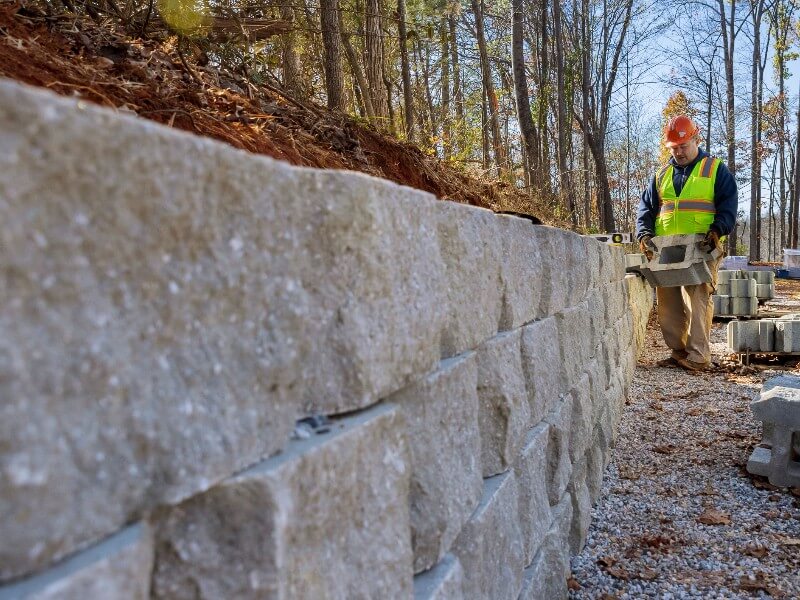
Before beginning construction, it's important to assess the surrounding terrain, especially if the project is on a slope or near a drop-off. Without proper precautions, the risk of landslides increases considerably. Therefore, it's imperative to include safety structures in your project, such as a retaining wall.
When properly constructed, this wall protects the land, the property, and everyone nearby. Even when a heavy building is located near a ravine, the wall helps maintain the land's stability. However, some care must be taken when constructing this essential element.
Follow along and learn more about retaining walls, their function, and how to build them safely.
As mentioned, a retaining wall is a structure designed to stabilize a slope to prevent landslides. Its main function is to balance the pressure exerted by the terrain, making it more stable. Therefore, it's also called a retaining wall.
One of the main reasons for building a retaining wall is to deal with rainfall, as water seeps into the ground and increases the weight of the terrain, causing landslides. Therefore, it's important to build a retaining wall even if the site appears stable.
This structure combines steel rebars, concrete, stone, and reinforcement pillars to provide maximum stability. The greater the weight or pressure that needs to be contained, the more important it is to consider the solidity and durability of this wall.
Retaining walls are divided into two categories, based on their material and construction method. See below.
This type of wall retains the slope through its weight and the arrangement of materials relative to the terrain. In other words, it uses heavier materials and a triangular shape to withstand external pressure and maintain its structure's stability.
Gravity walls are best suited for small slopes, less than 4 meters, where there is no need to support such a large amount of weight. Because the wall's stability depends on the weight and arrangement of the material, the total area occupied by its base increases exponentially in relation to its height, a characteristic that limits the installation locations for gravity walls.
A flexural wall is a suitable option for larger projects. This type of wall uses more robust materials, such as reinforced concrete, to maximize its resilience without increasing its weight or footprint. In some cases, it can be anchored with tie rods to increase its stability.
This wall is better suited to withstand greater external pressure without deformation. In many cases, it also offers a better aesthetic finish than gravity walls.
If you need to include a retaining wall in your project, good planning is essential. Learn how to build a retaining wall more safely here.
Before considering the project's structure, the most important thing is to analyze the terrain where the wall will be built. This includes its stability, composition, weight, and other factors that can influence the construction's safety.
It's worth noting that if a lot of trees and plants are present on a site, these natural elements provide some of its support. Therefore, by avoiding their removal during construction, it will be easier to build a stable and safe wall at its base.
After an initial site assessment, the planning stage of your project begins. This is where you evaluate what type of retaining wall you want to build, what the main materials involved, what measures should be taken to minimize risks, among other aspects.
Planning should consider slope support during and after construction. In many cases, a temporary structure is necessary to maintain ground stability until the wall is completed.
One aspect of every construction project that cannot be overlooked is land drainage. When it rains, the water must drain naturally in some direction, whether to a nearby stream or the local sewer system.
Without proper drainage, water accumulates on the ground, gradually increasing its weight and eroding the wall. In the long run, this compromises its foundation. steel and increases the risk of slipping.
With the other aspects already considered, it's time to determine the foundation on which the retaining wall will be installed. Since this foundation will support the entire weight, it needs to be constructed carefully to avoid long-term complications.
In many cases, the foundation is the same for the entire site, especially for larger buildings. However, if this isn't the case, you'll need to design a specific foundation for the wall. Otherwise, the ground may subside, rendering the structure useless.
You will create the steel skeleton for the construction of the retaining wall, which will be the basis for the formation of your structure, combining different types of rebar and other supporting materials to provide maximum stability.
Steel is the main component, as it offers flexibility and resistance. Without this material, the risk of cracks and breakage is much higher.
Finally, you must pour concrete over the steel structure. Once the material has cured, it will be solid and strong enough to support the weight of the slope and prevent landslides.
After pouring the concrete and checking the results, you can remove any temporary structures in place, making way for the permanent retaining wall. Continue monitoring the structure throughout the project to ensure no reinforcement is needed before completion.
As we've seen, with just a few steps, it's possible to build a retaining wall more safely. Whether for small projects or larger structures, it's essential to have good planning and choose the right materials for your structure to ensure the quality of the work and prevent risks.
Want to find the best steel for your projects? Then check out our products. Ceará Steel Group!